How to build an…
OK, hopefully you have read the Indoor Rock Climbing Wall “what materials to buy” page and have everything ready to go. Tools recommended are: circular saw, drill and bits, a hammer, tape measure, pencil, socket set, painting tools and something to open a paint tin. Being in a metric country, thats the measurements I will be using.
Alright, ready? Go!
Wait! hehe There are kinda 2 starting points, you can cut the sheets to the right sizes or drill holes for your bolt on climbing holds, screw on hold people can skip to cutting.
How to Build an Indoor Rock Climbing Wall, Step 1:
I chose to drill holes first because I was only cutting a small bit off each plywood sheet. If you are going to use bolt on climbing holds, and want it in a set pattern, now is the time! For screw on climbing holds, you can just screw em on at the end. I went with a diamond shaped pattern on my 2400 x 1200 plywood sheets. By sheer luck, I stumbled upon a pattern that worked like magic!
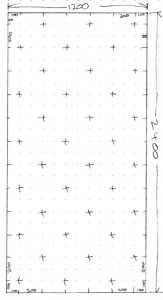
Measure 100mm in from each edge, then inside that, mark out 200mm increments along each edge, all the way around. Using your tape measure, line up from one side to the other and mark every 1st 200mm from one side to the other, starting from the 100mm border you created first, right in the corner of it. On the second row, mark every 2nd 200mm (400mm really).
Repeat all the way up the ply, every odd row should start on the 100mm border on the left and the alternate rows will actually be 300mm in from the edge (200mm from the 100mm border). Then do the same from the ends, making the first column on the 100mm border. Again, stagger the columns. This should be creating crosses evenly over the plywood, 400mm apart vertically and horizontally, but also creating a nice diaganol pattern as well.
Magically when you put two sheets of ply side by side or one above another, the spaces between all the marks are still even! Crazy…
How to Build an Indoor Rock Climbing Wall, Step 2:
Grab your drill and about a 10mm bit or speed bore to fit the T Nuts, only the shaft bit of the T Nut goes into the hole. Clamp all your sheets together with the marked out one on top. Drill through your marks, depending on how thick all your sheets are together, you might have to take it easy, pulling out every now and then to let the wood chips fall away from the bit. A clogged bit creates a lot of heat.
NOTE: Did you know smoke is what makes a drill bit sharp? If you let too much smoke out of your bit, it will get blunt. Smoke also runs all electrical items, like a drill, if the smoke comes out, more often than not, the drill will stop working 🙂
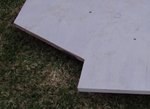
How to Build an Indoor Rock Climbing Wall, Step 3:
Cutting to size. Building my Indoor Rock Climbing Wall in a staircase with a raked ceiling made for some mad angles to cut. From the bottom of the second sheet I had to cut the start of the stairs, then at the top of each, the angle of the ceiling was different to the stairs… A piece of cardboard was great to make a template for the bottom of the stairs, but holding a tape measure up asking “helpers” is that straight up, didn’t really work for the raked ceiling. It was close, and looks ok but I will be more careful with the measurements next time. Measure twice, cut once!
A good way to get straight cuts is to measure from the side of deck on your circular saw that you are going to run along a straight egde, to the blade, then take that off your actual measurements and clamp a straight edge along this line on the side you are going to keep, so the offcut will fall away when you cut. You can do this while your sheets of ply are still stacked from drilling. Slide the top ones back to the length you need and use them as a straight edge, easy to get square too! I know, I know. They are heavy, grab a straight length of timber instead.
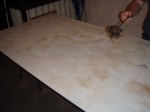
How to Build an Indoor Rock Climbing Wall, Step 4:
Painting the primer. I was a bit excited about the whole process and added sand at this point. I don’t think you need to. It wasn’t real successful. You can see me here sifting the sand through an aquarium net. It was close at hand alright!?
In reality, it probably wouldn’t matter if there were sticks and things in the sand and paint, but next time I will just put the primer on it own for the first coat.
How to Build an Indoor Rock Climbing Wall, Step 5:
Painting the masterpiece. If only I had some talent as a painter. Ideas of what it would look like finished made me try things that proper painters would have laughed at. Put a good couple of handfuls of sand into the roller tray and mix it up good, its surprising how much you need to make it sandy on the ply. Sand also sinks in paint, so you need to keep stirring.
 I tried to pick a colour that would blend in with the climbing holds, theres 3 sitting on the right hand sheet. Plus I got a tin of tint that I could add to the paint later to create more colours myself.
I tried to pick a colour that would blend in with the climbing holds, theres 3 sitting on the right hand sheet. Plus I got a tin of tint that I could add to the paint later to create more colours myself.
NOTE: Tint is not really paint, nor is it meant to be used straight, I learned this while painting features on the climbing wall… it took a long time to dry…
Lying the sheets out as they would appear on the wall made the task of lining up my giant work of art a bit easier. For the main body of colour, use a roller and a roller tray with the paint in it, also your handfull of sand. Paint rollers make the painting much faster. If a plain colour is how you would like your wall to look, give it a couple of coats of your main colour with sand in it, then stop, job well done!
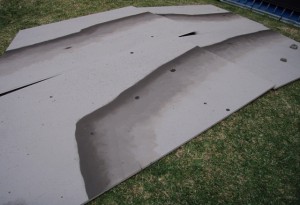 If you want a truly unique (unique not always meaning something good), then add some features! I was going for the “looks like an indoor rock climbing wall but more real” look. To achieve this, add some tint to your roller tray, not the remaining paint in the tin. You may want to correct some artistically challenged decisions later. Grab your paint brush and go to town! Adding darker regions using a cross hatching motion “blends” a bit with the background. A bit more tint, then go again, covering a bit of the layer you just did. Repeat until you have as dark as you want, then paint a fairly solid brush width to finish the colour sharply.
If you want a truly unique (unique not always meaning something good), then add some features! I was going for the “looks like an indoor rock climbing wall but more real” look. To achieve this, add some tint to your roller tray, not the remaining paint in the tin. You may want to correct some artistically challenged decisions later. Grab your paint brush and go to town! Adding darker regions using a cross hatching motion “blends” a bit with the background. A bit more tint, then go again, covering a bit of the layer you just did. Repeat until you have as dark as you want, then paint a fairly solid brush width to finish the colour sharply.
A good idea at the time was to paint all imperfections in this same shade or tint darker still, knots look especially good darker coz they look like holes in the rock. Make sure you add the tint to paint… ages to dry people! Then with your brush away from your person, spatter the whole shebang lightly, this gives a nice imperfect “its a rock face not an indoor rock climbing wall” feel. Try not to have too much paint on the brush when performing this trick, big spatters of paint aren’t really that rock face like.
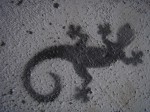
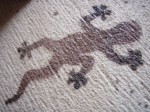 Another trick is stencilling. Take a picture you want, the simpler the better, print it onto cardboard, or draw it onto a cereal box, stanley knife it out. Masking tape it in place, grab a can of spray paint, go nuts! If you get adventurous, or actually have some skill with a paint brush, can you come over to my place and paint some greenery on it too? I would like a couple of vines please. You could also paint your favourite outdoor climbs, or a mountain scene, or a giant tree Jack and the Beanstalk style, clouds might be nice. OR if you live in retro town like I do (see the nice wallpaper in later shots) wallpapering the ply to make it blend back in would look pretty tricky too! The ply’s the limit!
Another trick is stencilling. Take a picture you want, the simpler the better, print it onto cardboard, or draw it onto a cereal box, stanley knife it out. Masking tape it in place, grab a can of spray paint, go nuts! If you get adventurous, or actually have some skill with a paint brush, can you come over to my place and paint some greenery on it too? I would like a couple of vines please. You could also paint your favourite outdoor climbs, or a mountain scene, or a giant tree Jack and the Beanstalk style, clouds might be nice. OR if you live in retro town like I do (see the nice wallpaper in later shots) wallpapering the ply to make it blend back in would look pretty tricky too! The ply’s the limit!
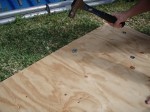
How to Build an Indoor Rock Climbing Wall, Step 6:
Phew, step 5 was huge! Now onto TEE or T Nuts. Get your box of goodies… hang on, better still, ask someone else to go grab your bag of nuts. 😀 Also your trusty hammer. Flip the ply over, insert a T nut, shaft first / spikes down, into a predrilled hole. Hit with vigour. Find a set of ear muffs or plugs, install, repeat T Nut beating until it wont go in no more. Keep going until all holes are full of nuts. Try to hit them squarely so as not to break the front of the ply, which should be beautifully painted. Why paint it first? Well in theory, there will now be no paint on the threads of the T Nuts.
How to Build an Indoor Rock Climbing Wall, Step 7:
Find studs. Grab your stud finder! Masking tape (its like paper, not plastic) is a great invention, it sticks when it has to and doesn’t usually leave marks or take paint off when you remove it. Follow the instructions for using your particular stud finder, typically its hold down a button, slide across wall, watch and listen for when a stud (or pipes and power) lights it up or beeps, mark on wall when the lights and sound starts, then keep sliding and mark when it ends, smack in the center should be your stud. The masking tape is because when you stand the plywood up against the wall, you can’t see any marks you made. Mark out a few on each vertical stud, at least one top and bottom, then put the masking tape on the floor and ceiling, lining up with the stud. Slide further sideways to find the surrounding studs. You might find the tape on the floor is pretty evenly spaced, most are either 450mm or 600mm spacing in Australia. Best to actually find them.
Find a row or two of noggins as well by sliding the stud finder up and down, there might only be one through the middle, and between each pair of studs, they may also be staggered across the width of the wall so masking tape written on up each side for higher or lower noggins might be useful. Finding noggins is not critical because the structural ply is way strong enough to hold everything up just fixing to studs. I found I needed a couple of noggins because the wall may not have been perfectly flat and the edge of the plywood sheet sat out a bit from the one beside it.
Just to be sure, you can use a small drill bit in your drill and drill into the wall where you think the stud should be, if you strike timber, congrats! If water comes out, find a phonebook and an emergency plumber. As a general rule, if there are power points, light switches, taps or other service on the wall, there could be those services inside the wall, I take no responsibility for you “finding” these things. If you are unsure, as always, ask a professional!
How to Build an Indoor Rock Climbing Wall, Step 8:
Mount your indoor rock climbing wall that looks like a real rock face! Getting closer! …
… To be continued …
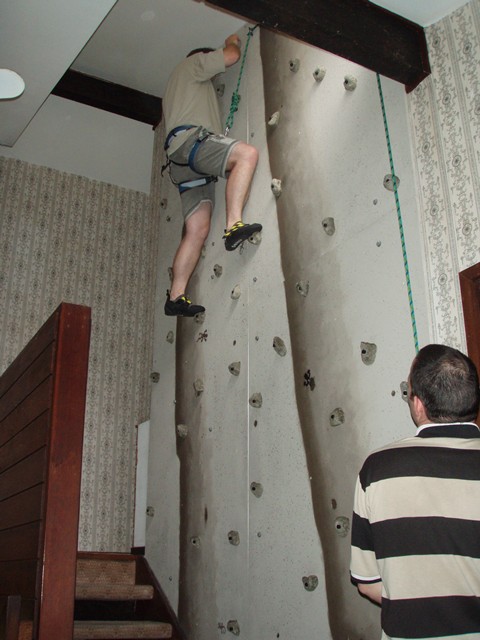
hello, thanks for your really clear description. Im building a wall in my art studio. where did you get the holds and tee nuts from?? i would like a belay system that the climber is able to control – just so i dont need torely on a2nd person, do you know of any systems fittingthat description??
thanks alison
I have been looking into this also as a self belay would be handy for personal climbing walls. There are a few Gri Gri’s about and “fall arresters”, so far I have not picked one up for myself. What I really want to see is what is inside those mobile climbing walls that folds up off a trailer and looks like a big tree trunk of rock climbing wall. They pop up at town fairs and kids parties where the kids (upto 4 at a time) climb a different side of the wall at the same time with no one belaying them. When I find what suits best, I will post it! Cheers.
As to where I bought the Climbing Holds and T-Nuts from… I don’t really want to give out names of brands on here, but the holds came from the USA off Ebay, I wanted ones that looked like rocks, not fluro plastic. I am hoping to get a page setup where I can resell his holds in Australia as they look and feel great. No big jugs or fancy shapes though.
The T-nuts came from a local “fastener” supplier (they had them on the shelf), looks like there is a plywood place near you that may be able to get them, or a fastener place at Nowra. Just google fastener and they should pop up 🙂 Or good ‘ol Ebay.
Usually the places that sell holds also supply them with nuts and bolts.
Oh and there are “Bolt Ons” and “Screw Ons”. eg. they either Bolt on, or Screw on to the climbing wall. I used bolt ons that require the T Nuts, Screw ons do not. Personally I trust the bolt going through the ply into a T nut more than a screw just into the ply… Hope that helps!
What thickness of ply wood did you use… I’m looking for us measurements btw lol… I just want to make sure my t nuts don’t pull through.
Hi Drew,
I used 15mm Structural Ply approx 3/5 of an inch, I have listed all materials and the prices I paid (in Australian Dollars) on the What materials to buy page. Good luck, and rock on!
awesome guide man. I’m going to be making some video tutorials on the fake boulders I built on mine. no joke, learned the trade from an old disney imagineer. mine is outdoor, but a lot can be transfered to inside walls. http://m.youtube.com/index?client=mv-google&desktop_uri=%2F&gl=US&rdm=4phc78bms#/watch?v=1g4AIFBcNs0 Keep an eye on it, it’s climbing season again, so we will be uploading videos every week. I’ve also found an amazing guy that builds recycled holds and sells for next to nothing. just drop a comment on youtube if you want additional info on how I built something or anything else.
jem
admin, are you using carls holds also? they are the best!
Hi there,
I don’t know who Carl is 🙂 I found them on ebay and liked them because they were more realistic looking. Yeah these are apparently 40% recycled and aerospace epoxy or something like that… Whatever they are, they are great holds!